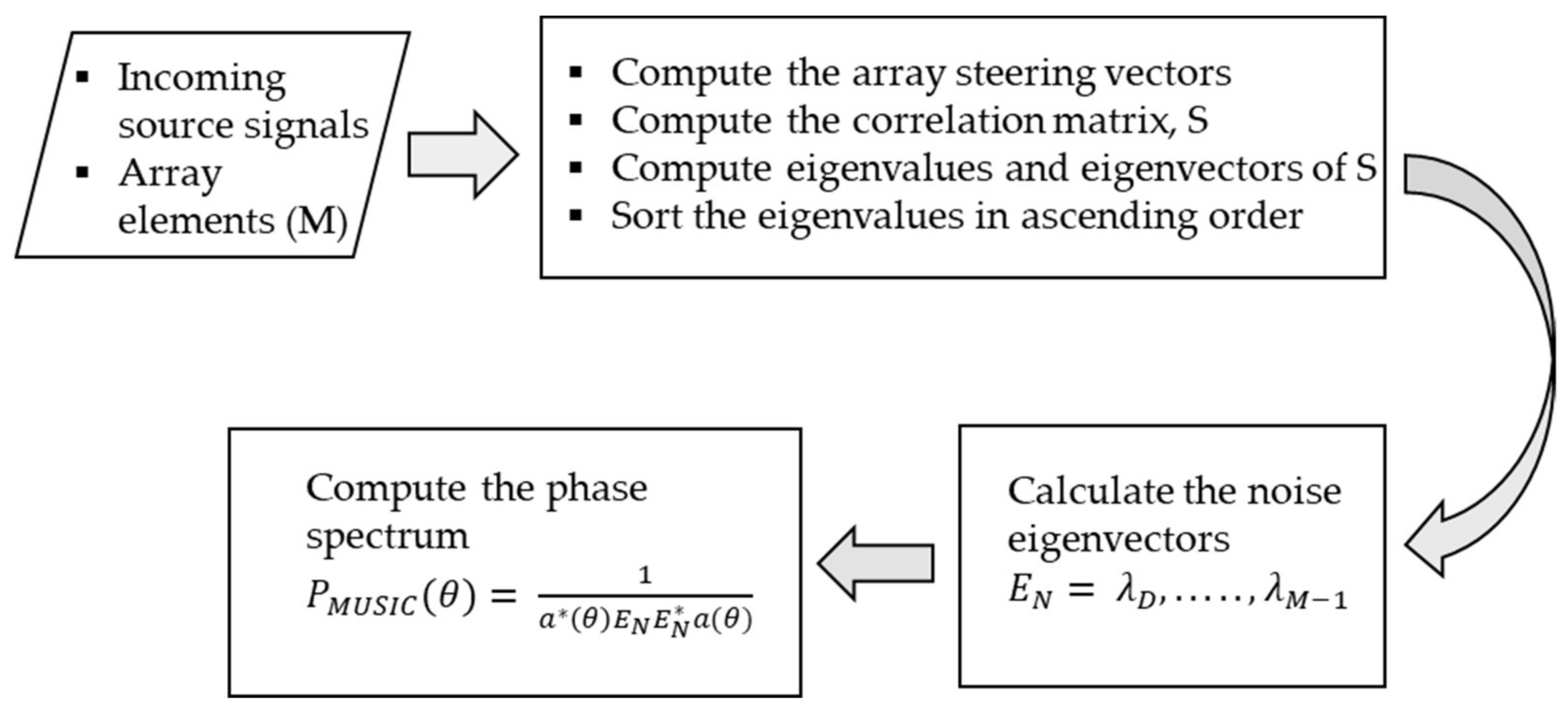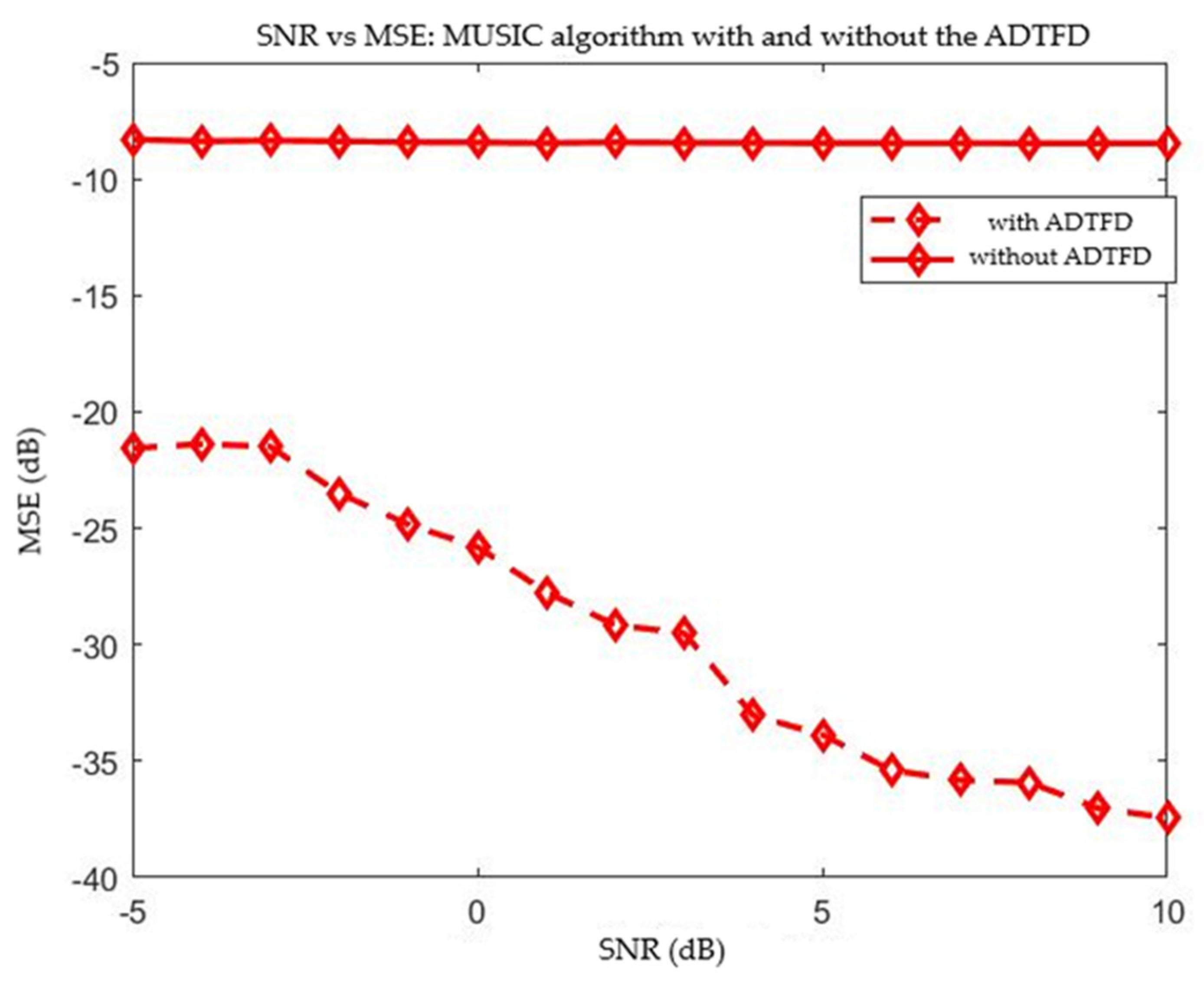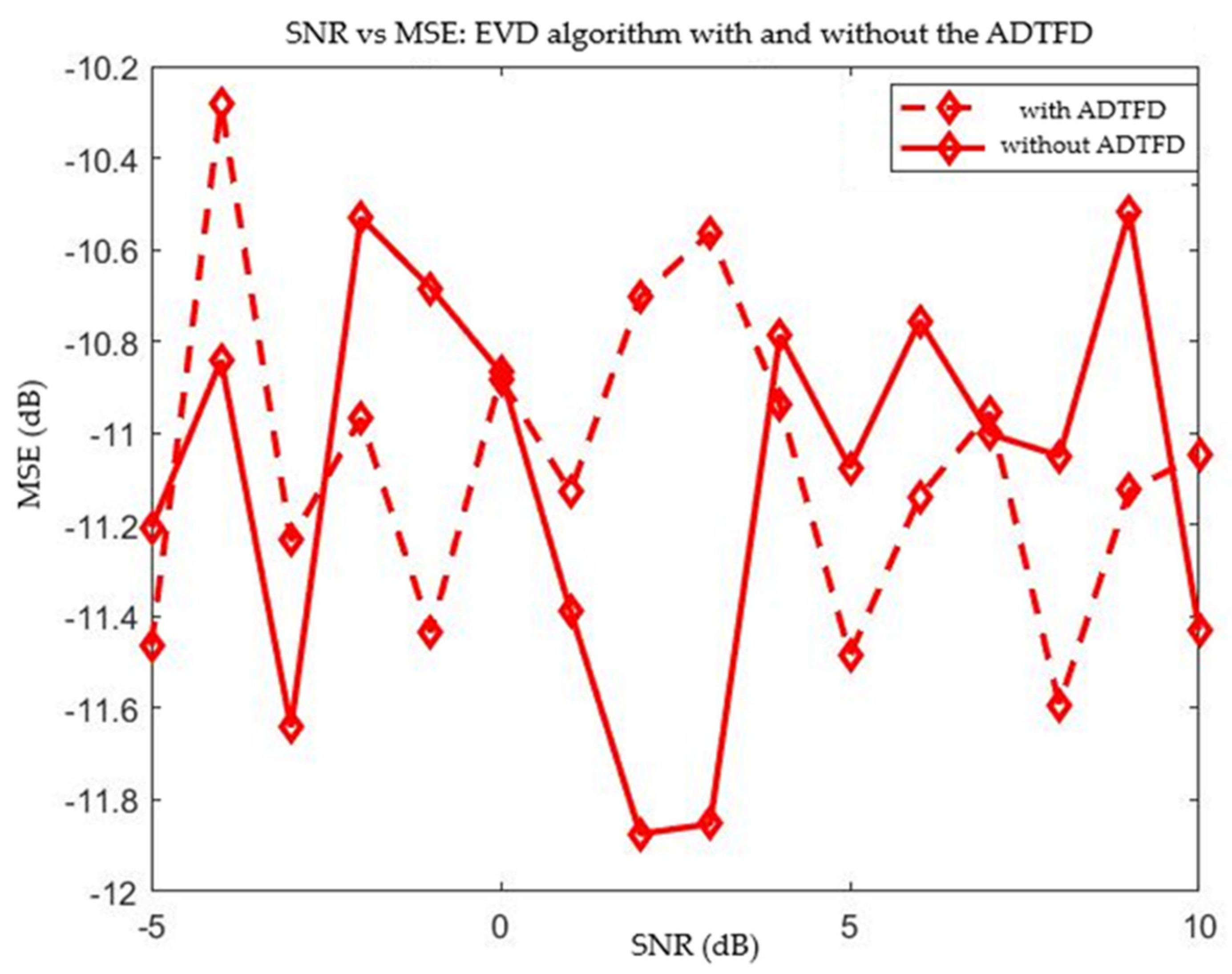An Overview of Direction-of-Arrival Estimation Methods Using Adaptive Directional Time-Frequency Distributions
Abstract
:1. Introduction
2. Literature Review
3. DOA Estimation Algorithms
3.1. The MUSIC Algorithm
3.2. The ESPRIT Algorithm
3.3. Eigenvector Clustering Algorithm
4. Adaptive Directional Time–Frequency Distributions (ADTFD)
4.1. Spatial Averaging of TFDs
4.2. Multi-Component Analysis
5. Special Case: Experimental Results and Discussions
6. Conclusions
Author Contributions
Funding
Conflicts of Interest
References
- Bartlett, M.S. Periodogram Analysis and Continuous Spectra. Biometrika 1950, 37, 1–16. [Google Scholar] [CrossRef] [PubMed]
- Schmidt, R. Multiple emitter location and signal parameter estimation. IEEE Trans. Antennas Propag. 1986, 34, 276–289. [Google Scholar] [CrossRef] [Green Version]
- Roy, R.; Paulraj, A.; Kailath, T. Estimation of Signal Parameters via Rotational Invariance Techniques—Esprit. In Proceedings of the Nineteeth Asilomar Conference on Circuits, Systems and Computers, Pacific Grove, CA, USA, 6–8 November 1985; pp. 41.6.1–41.6.5. [Google Scholar]
- Wang, R.; Wang, Y.; Li, Y.; Cao, W.; Yan, Y. Geometric Algebra-Based ESPRIT Algorithm for DOA Estimation. Sensors 2021, 21, 5933. [Google Scholar] [CrossRef]
- Luan, S.; Li, J.; Gao, Y.; Zhang, J.; Qiu, T. Generalized covariance-based ESPRIT-like solution to direction of arrival estimation for strictly non-circular signals under Alpha-stable distributed noise. Digit. Signal Process. 2021, 118, 103214. [Google Scholar] [CrossRef]
- Mankal, P.; Gowre, S.C.; Dakulagi, V. A New DOA Algorithm for Spectral Estimation. Wirel. Pers. Commun. 2021, 119, 1729–1741. [Google Scholar] [CrossRef]
- Al Mahmud, T.H.; Ye, Z.; Shabir, K.; Sheikh, Y.A. DOA Estimation of Quasi-Stationary Signals Exploiting Virtual Extension of Coprime Array Imbibing Difference and Sum Co-Array. IEICE Trans. Commun. 2018, E101.B, 18761883. [Google Scholar] [CrossRef]
- Mohan, S.; Lockwood, M.E.; Kramer, M.L.; Jones, D.L. Localization of multiple acoustic sources with small arrays using a coherence test. J. Acoust. Soc. Am. 2008, 123, 2136–2147. [Google Scholar] [CrossRef] [Green Version]
- Swartling, M.; Sallberg, B.; Grbic, N. Direction of arrival estimation for speech sources using fourth order cross cumulants. In Proceedings of the 2008 IEEE International Symposium on Circuits and Systems (ISCAS), Seattle, WA, USA, 18–21 May 2008; pp. 1696–1699. [Google Scholar] [CrossRef] [Green Version]
- Tho, N.T.N.; Zhao, S.; Jones, D.L. Robust DOA estimation of multiple speech sources. In Proceedings of the 2014 IEEE International Conference on Acoustics, Speech and Signal Processing (ICASSP), Florence, Italy, 4–9 May 2014; pp. 2287–2291. [Google Scholar]
- Dey, A.; Nandi, A.; Basu, B. Gold-MUSIC based DOA estimation using ULA antenna of DS-CDMA sources with propagation delay diversity. AEU Int. J. Electron. Commun. 2018, 84, 162–170. [Google Scholar] [CrossRef]
- Shi, Z.; Zhou, C.; Gu, Y.; Goodman, N.A.; Qu, F. Source Estimation Using Coprime Array: A Sparse Reconstruction Perspective. IEEE Sens. J. 2017, 17, 755–765. [Google Scholar] [CrossRef]
- Zhou, C.; Gu, Y.; Zhang, Y.D.; Shi, Z.; Jin, T.; Wu, X. Compressive sensing-based coprime array direction-of-arrival estimation. IET Commun. 2017, 11, 1719–1724. [Google Scholar] [CrossRef]
- Zheng, H.; Shi, Z.; Zhou, C.; Haardt, M.; Chen, J. Coupled Coarray Tensor CPD for DOA Estimation with Coprime L-Shaped Array. IEEE Signal Process. Lett. 2021, 28, 1545–1549. [Google Scholar] [CrossRef]
- Hameed, K.; Khan, W.; Abdalla, Y.S.; Al-Harbi, F.F.; Armghan, A.; Asif, M.; Salman Qamar, M.; Ali, F.; Miah, M.S.; Alibakhshikenari, M.; et al. Far-Field DOA Estimation of Uncorrelated RADAR Signals through Coprime Arrays in Low SNR Regime by Implementing Cuckoo Search Algorithm. Electronics 2022, 11, 558. [Google Scholar] [CrossRef]
- Hioka, Y.; Hamada, N. DOA estimation of speech signal using equilateral-triangular microphone array. In Proceedings of the 8th European Conference on Speech Communication and Technology, Geneva, Switzerland, 1–4 September 2003; pp. 1717–1720. [Google Scholar]
- Basikolo, T.; Ichige, K.; Arai, H. Direction of arrival estimation for quasi-stationary signals using nested circular array. In Proceedings of the 2016 4th International Workshop on Compressed Sensing Theory and its Applications to Radar, Sonar and Remote Sensing (CoSeRa), Aachen, Germany, 19–22 September 2016; pp. 193–196. [Google Scholar]
- Xu, L.; Wen, F. Fast Noncircular 2D-DOA Estimation for Rectangular Planar Array. Sensors 2017, 17, 840. [Google Scholar] [CrossRef] [Green Version]
- Zhai, H.; Zhang, X.; Zheng, W.; Gong, P. DOA Estimation of Noncircular Signals for Unfolded Coprime Linear Array: Identifiability, DOF and Algorithm. IEEE Access 2018, 6, 29382–29390. [Google Scholar] [CrossRef]
- Aigang, F.; Zheng, Z.; Qinye, Y. Wideband direction-of-arrival estimation using fast chirplet-based adaptive signal decomposition algorithm. In Proceedings of the IEEE 54th Vehicular Technology Conference. VTC Fall 2001. Proceedings (Cat. No.01CH37211), Atlantic City, NJ, USA, 7–11 October 2001; pp. 1432–1436. [Google Scholar]
- Gershman, A.B.; Amin, M.G. Wideband direction-of-arrival estimation of multiple chirp signals using spatial time-frequency distributions. IEEE Signal Process. Lett. 2000, 7, 152–155. [Google Scholar] [CrossRef]
- Bouri, M. Source Detection and Localization in Array Signal Processing. In Proceedings of the First International Symposium on Environment Identities and Mediterranean Area, Corte-Ajaccio, France, 9–12 July 2006; pp. 12–17. [Google Scholar] [CrossRef]
- Nishiura, T.; SNakamura, S.; Shikano, K. Talker localization in a real acoustic environment based on DOA estimation and statistical sound source identification. In Proceedings of the IEEE International Conference on Acoustics, Speech, and Signal Processing, Orlando, FL, USA, 13–17 May 2002; pp. I-893–I-896. [Google Scholar] [CrossRef] [Green Version]
- Sawada, H.; Mukai, M.; Makino, S. Direction of arrival estimation for multiple source signals using independent component analysis. In Proceedings of the Seventh International Symposium on Signal Processing and Its Applications, Paris, France, 4 July 2003; pp. 411–414. [Google Scholar] [CrossRef] [Green Version]
- Matsuo, M.; Hioka, Y.; Hamada, N. Estimating DOA of Multiple Speech Signals by Improved Histogram Mapping Method. In Proceedings of the International Workshop on Acoustic Echo and Noise Control (IWAENC), High Tech Campus, Eindhoven, The Netherlands, 12–15 September 2005; pp. 129–132. [Google Scholar]
- Wang, W.; Zhang, W. Joint beam training and positioning for intelligent reflecting surfaces assisted millimeter-wave communications. IEEE Trans. Wirel. Commun. 2021, 20, 6282–6297. [Google Scholar] [CrossRef]
- Chi, Y.; Scharf, L.L.; Pezeshki, A.; Calderbank, A.R. Sensitivity to basis mismatch in compressed sensing. IEEE Trans. Signal Process. 2011, 59, 2182–2195. [Google Scholar] [CrossRef]
- Yang, Z.; Xie, L.; Zhang, C. A discretization-free sparse and parametric approach for linear array signal processing. IEEE Trans. Signal Process. 2014, 62, 4959–4973. [Google Scholar] [CrossRef] [Green Version]
- Kase, Y.; Nishimura, T.; Ohgane, T.; Ogawa, Y.; Kitayama, D.; Kishiyama, Y. DOA Estimation of Two Targets with Deep Learning. In Proceedings of the 15th Workshop on Positioning, Navigation and Communications (WPNC), Bremen, Germany, 25–26 October 2018; pp. 1–5. [Google Scholar] [CrossRef]
- Liu, Y.; Chen, H.; Wang, B. DOA estimation based on CNN for underwater acoustic array. Appl. Acoust. 2021, 172, 107594. [Google Scholar] [CrossRef]
- Lin, L.; She, C.; Chen, Y.; Guo, Z.; Zeng, X. TB-NET: A Two-Branch Neural Network for Direction of Arrival Estimation under Model Imperfections. Electronics 2022, 11, 220. [Google Scholar] [CrossRef]
- Hoang, D.T.; Lee, K. Deep Learning-Aided Coherent Direction-of-Arrival Estimation with the FTMR Algorithm. IEEE Trans. Signal Process. 2022, 70, 1118–1130. [Google Scholar] [CrossRef]
- Papageorgiou, G.K.; Sellathurai, M.; Eldar, Y.C. Deep Networks for Direction-of-Arrival Estimation in Low SNR. IEEE Trans. Signal Process. 2021, 69, 3714–3729. [Google Scholar] [CrossRef]
- Asano, F.; Hayamizu, S.; Yamada, T.; Nakamura, S. Speech enhancement based on the subspace method. IEEE Trans. Speech Audio Process. 2000, 8, 497–507. [Google Scholar] [CrossRef] [Green Version]
- Visser, E.; Lee, T.; Otsuka, M. Speech enhancement in a noisy car environment. In Proceedings of the 3rd International Conference on Independent Component Analysis and Source Separation, San Diego, CA, USA, 9–13 December 2001; pp. 272–277. [Google Scholar]
- Mitianoudis, N.; Davies, M.E. Audio source separation: Solutions and problems. Int. J. Adapt. Control Signal Process. 2004, 18, 299–314. [Google Scholar] [CrossRef]
- Yermeche, Z.; Grbic, N.; Claesson, I. Speech enhancement of multiple moving sources based on subband clustering time-delay estimation. In Proceedings of the International Workshop on Acoustic Echo and Noise Control (IWAENC), Paris, France, 12–14 September 2006; pp. 1–4. [Google Scholar]
- Ali Khan, N.; Ali, S.; Jansson, M. Direction of arrival estimation using adaptive directional time-frequency distributions. Multidimens. Syst. Signal Process. 2018, 29, 503–521. [Google Scholar] [CrossRef]
- Habets, E.A.R.; Gannot, S. Dual-Microphone Speech Dereverberation using a Reference Signal. In Proceedings of the 2007 IEEE International Conference on Acoustics, Speech and Signal Processing (ICASSP ’07), Honolulu, HI, USA, 15–20 April 2007; pp. IV-901–IV-904. [Google Scholar] [CrossRef] [Green Version]
- Gu, J.; Chan, S.C.; Zhu, W.; Swamy, M.N.S. Joint DOA Estimation and Source Signal Tracking with Kalman Filtering and Regularized QRD RLS Algorithm. IEEE Trans. Circuits Syst. II 2013, 60, 46–50. [Google Scholar] [CrossRef]
- Bachu, R.; Kopparthi, S.; Adapa, B.; Barkana, B. Voiced/Unvoiced Decision for Speech Signals Based on Zero-Crossing Rate and Energy. In Advanced Techniques in Computing Sciences and Software Engineering; Springer: Dordrecht, The Netherlands, 2010. [Google Scholar] [CrossRef]
- Amin, M.G.; Zhang, Y. Direction finding based on spatial time-frequency distribution matrices. Digit. Signal Process. 2000, 10, 325–339. [Google Scholar] [CrossRef] [Green Version]
- Zhang, Y.; Ma, W.; Amin, M. Subspace analysis of spatial time-frequency distribution matrices. IEEE Trans. Signal Process. 2001, 49, 747–759. [Google Scholar] [CrossRef] [Green Version]
- Chabriel, G.; Kleinsteuber, M.; Moreau, E.; Shen, H.; Tichavsky, P.; Yeredor, A. Joint matrices decompositions and blind source separation: A survey of methods, identification, and applications. IEEE Signal Process. Mag. 2014, 31, 34–43. [Google Scholar] [CrossRef]
- Belouchrani, A.; Amin, M. Time-frequency MUSIC. IEEE Signal Process. Lett. 1999, 6, 109–110. [Google Scholar] [CrossRef]
- Belouchrani, A.; Amin, M.; Thirion-Moreau, N.; Zhang, Y. Source separation and localization using time-frequency distributions: An overview. IEEE Signal Process. Mag. 2013, 30, 97–107. [Google Scholar] [CrossRef]
- Heidenreich, P.; Cirillo, L.; Zoubir, A. Morphological image processing for FM source detection and localization. Signal Process. 2009, 89, 1070–1080. [Google Scholar] [CrossRef]
- Sharif, W.; Chakhchoukh, Y.; Zoubir, A. Robust spatial time-frequency distribution matrix estimation with application to direction-of-arrival estimation. Signal Process. 2011, 91, 2630–2638. [Google Scholar] [CrossRef]
- Rankine, L.; Mesbah, M.; Boashash, B. IF estimation for multicomponent signals using image processing techniques in the time-frequency domain. Signal Process. 2007, 87, 1234–1250. [Google Scholar] [CrossRef] [Green Version]
- Zhang, H.; Bi, G.; Yang, W.; Razul, S.; See, C. IF estimation of FM signals based on time-frequency image. IEEE Trans. Aerosp. Electron. Syst. 2015, 51, 326–343. [Google Scholar] [CrossRef]
- Boashash, B. Time-Frequency Signal Analysis and Processing, a Comprehensive Reference. In EURASIP and Academic Press Series in Signal and Image Processing; Academic Press: Cambridge, MA, USA, 2016. [Google Scholar]









| DOA Estimation without ADTFD Algorithm | ||||||||||||
|---|---|---|---|---|---|---|---|---|---|---|---|---|
| SNR (dB) | MUSIC | ESPRIT | EVD | |||||||||
| T1 | T2 | T3 | T4 | T1 | T2 | T3 | T4 | T1 | T2 | T3 | T4 | |
| −5 dB | 35 | 35 | 35 | 35 | 0 | 2 | 74 | 0 | 13 | 32 | 40 | 67 |
| 0 dB | 36 | 36 | 36 | 36 | 0 | 9 | 58 | 0 | 18 | 22 | 43 | 58 |
| 5 dB | 37 | 37 | 37 | 37 | 0 | 14 | 49 | 0 | 6 | 31 | 39 | 79 |
| 10 dB | 37 | 37 | 37 | 37 | 0 | 14 | 49 | 0 | 12 | 45 | 45 | 83 |
| DOA Estimation with ADTFD Algorithm | ||||||||||||
|---|---|---|---|---|---|---|---|---|---|---|---|---|
| SNR (dB) | MUSIC | ESPRIT | EVD | |||||||||
| T1 | T2 | T3 | T4 | T1 | T2 | T3 | T4 | T1 | T2 | T3 | T4 | |
| −5 dB | 18 | 30 | 50 | 58 | 0 | 8 | 59 | 0 | 15 | 39 | 41 | 62 |
| 0 dB | 16 | 34 | 43 | 57 | 0 | 10 | 56 | 0 | 17 | 32 | 49 | 66 |
| 5 dB | 16 | 29 | 42 | 59 | 0 | 18 | 44 | 0 | 19 | 54 | 31 | 41 |
| 10 dB | 16 | 30 | 44 | 61 | 0 | 9 | 57 | 0 | 3 | 28 | 32 | 48 |
| Method | Without ADTFD | With ADTFD |
|---|---|---|
| MUSIC | 0.30 s | 1.83 s |
| ESPRIT | 0.10 s | 1.54 s |
| Eigenvalue decomposition | 0.21 s | 1.66 s |
Publisher’s Note: MDPI stays neutral with regard to jurisdictional claims in published maps and institutional affiliations. |
© 2022 by the authors. Licensee MDPI, Basel, Switzerland. This article is an open access article distributed under the terms and conditions of the Creative Commons Attribution (CC BY) license (https://creativecommons.org/licenses/by/4.0/).
Share and Cite
Eranti, P.K.; Barkana, B.D. An Overview of Direction-of-Arrival Estimation Methods Using Adaptive Directional Time-Frequency Distributions. Electronics 2022, 11, 1321. https://doi.org/10.3390/electronics11091321
Eranti PK, Barkana BD. An Overview of Direction-of-Arrival Estimation Methods Using Adaptive Directional Time-Frequency Distributions. Electronics. 2022; 11(9):1321. https://doi.org/10.3390/electronics11091321
Chicago/Turabian StyleEranti, Pranav Kumar, and Buket D. Barkana. 2022. "An Overview of Direction-of-Arrival Estimation Methods Using Adaptive Directional Time-Frequency Distributions" Electronics 11, no. 9: 1321. https://doi.org/10.3390/electronics11091321






